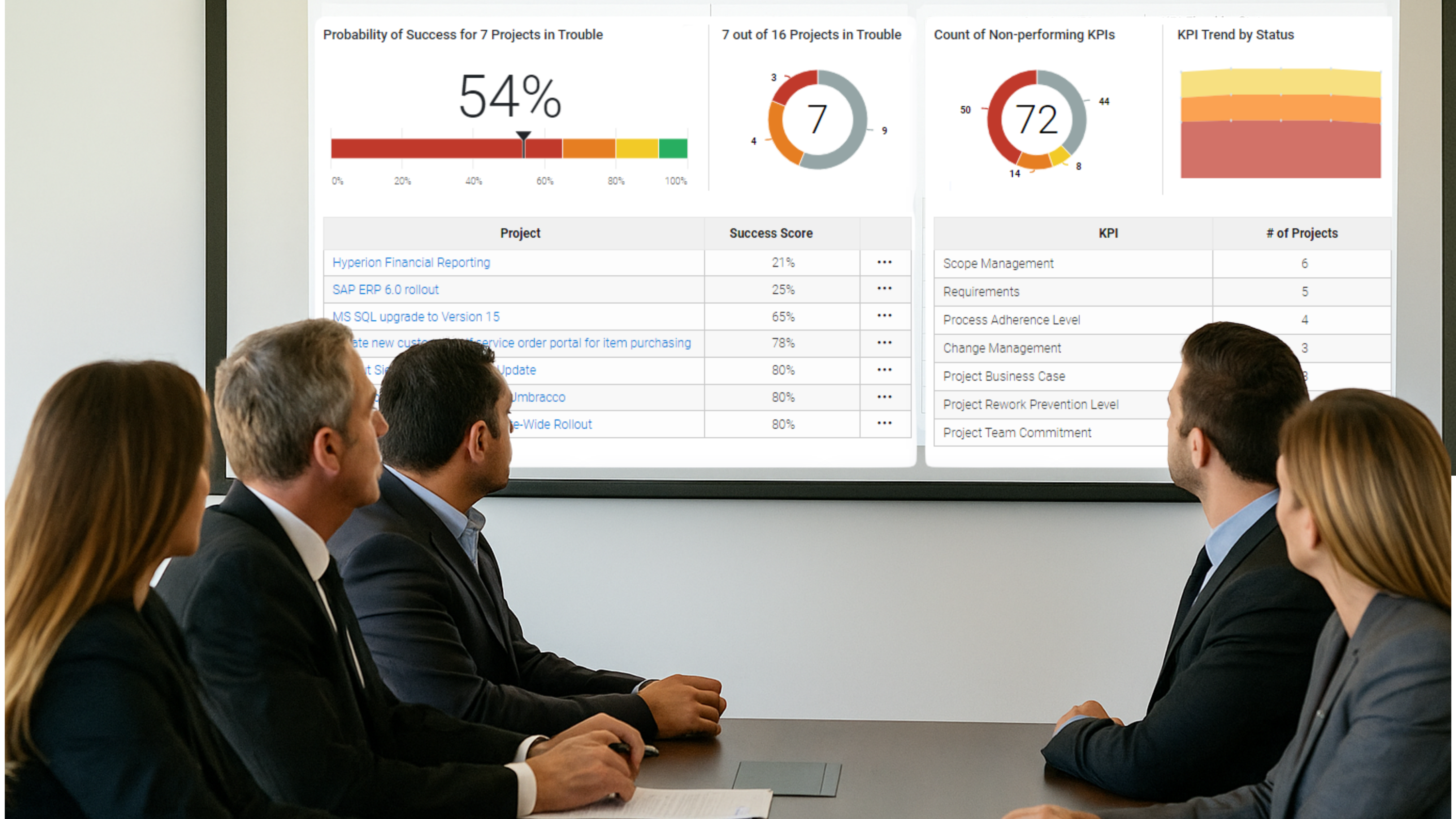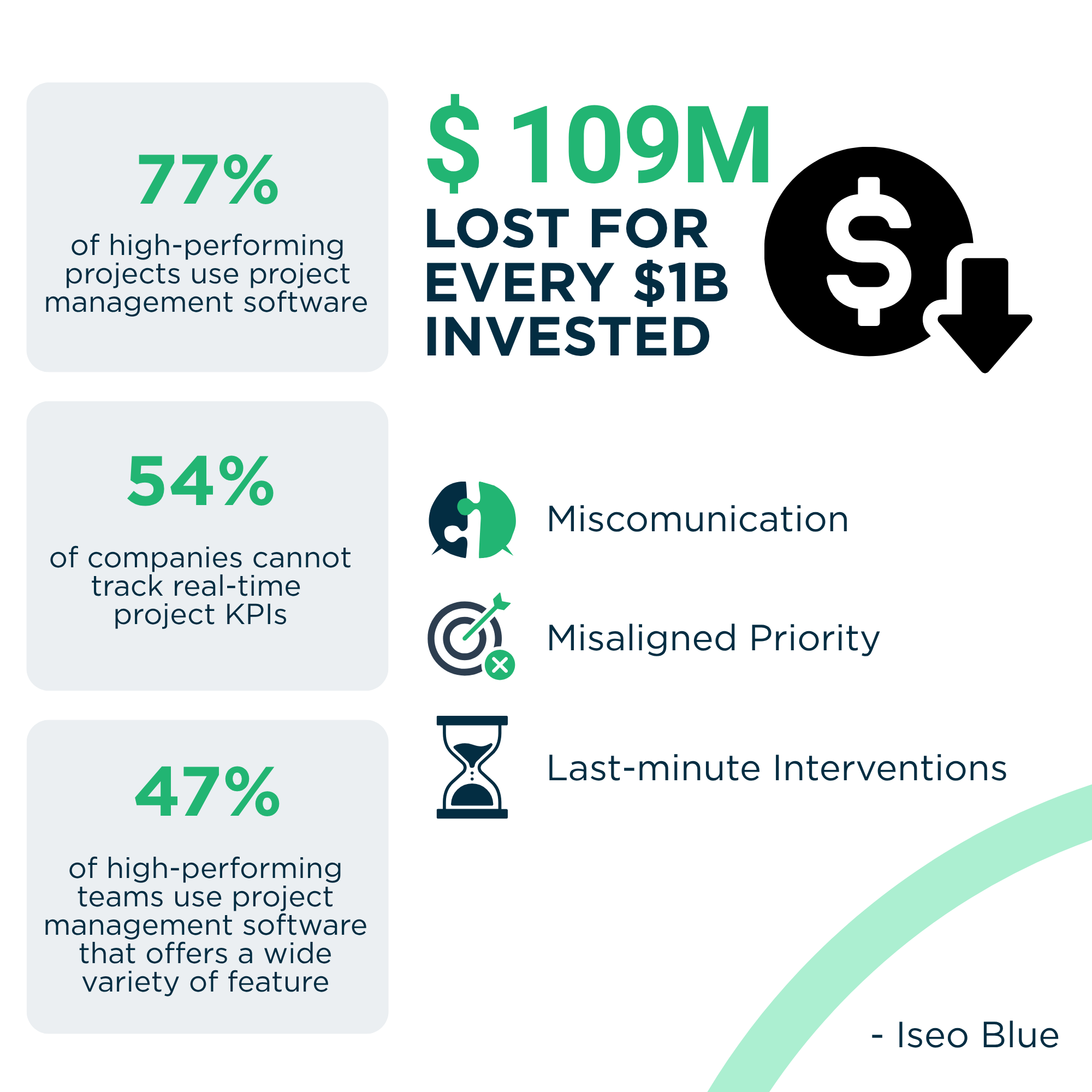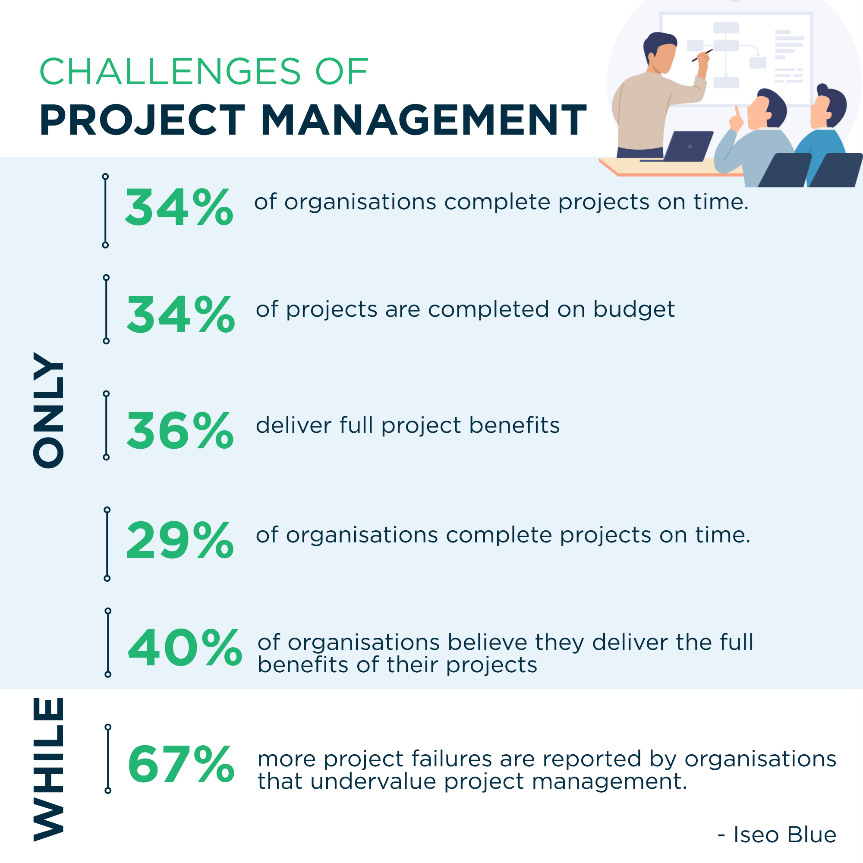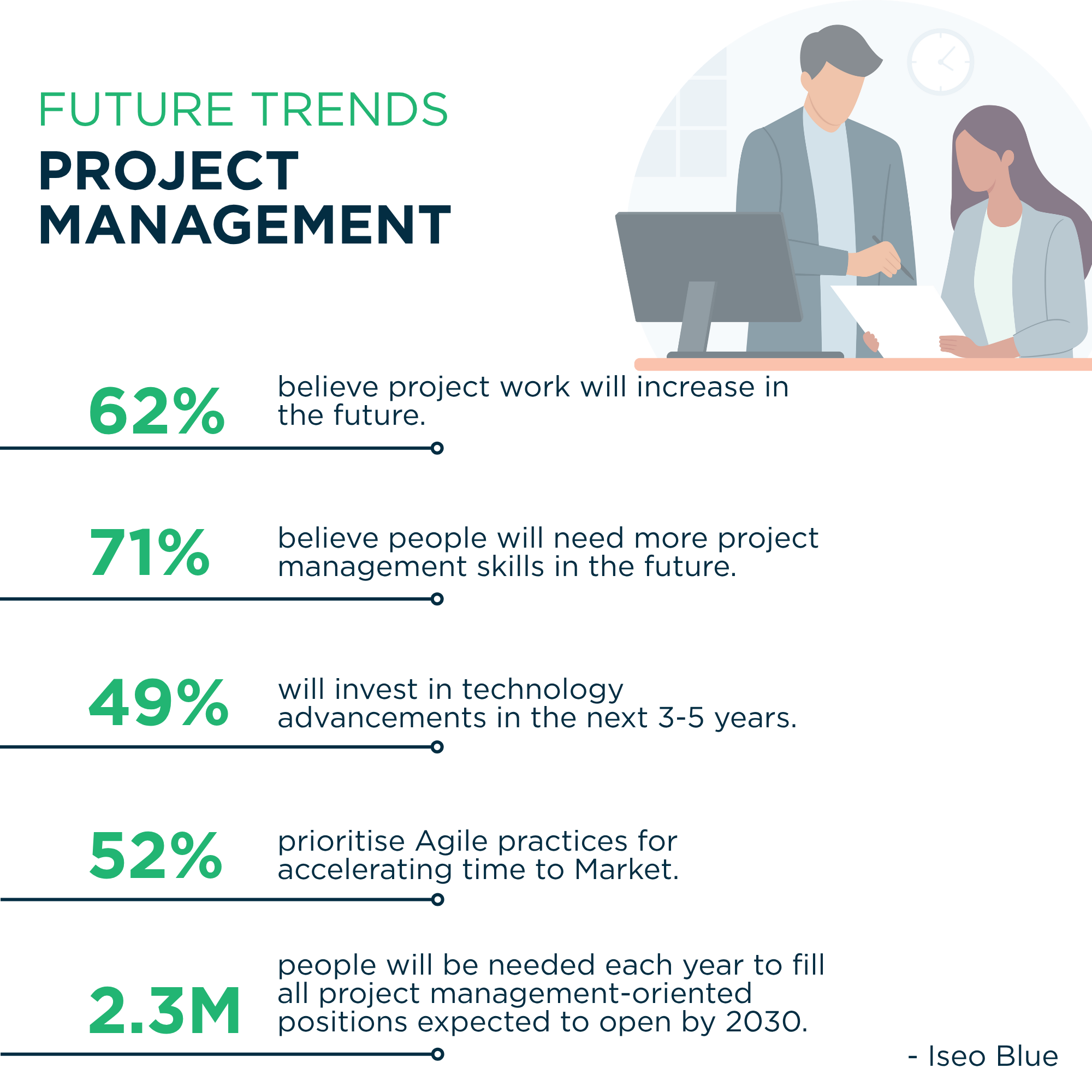
Quick Summary: Project management software has evolved into a strategic engine powered by predictive intelligence. The article explores the must-have capabilities, challenges, and ROI strategies leaders need—culminating in why TrueProject is the most logical, enterprise-grade solution to proactively manage, align, and deliver high-impact project outcomes.
Every year, corporations absorb massive losses due to failed or delayed initiatives. Recent data states that organizations lose as much as $109 million per $1 billion invested because of poor project execution and lack of foresight. These aren’t overruns—they’re symptomatic of deeper issues: miscommunication, misaligned priorities, and late-stage interventions. In today’s volatile economy, such inefficiencies are no longer acceptable.
The modern project landscape—marked by distributed teams, split-second decisions, agile workflows, and increasing sustainability mandates—has turned project delivery into a strategic function.  In this context, a project management software must evolve from a simple tracking tool into a strategic intelligence hub.
In this context, a project management software must evolve from a simple tracking tool into a strategic intelligence hub.
Traditional platforms focus on timelines and budgets, but the real challenge is what lies beneath: unseen risks and clouded decision pathways. In 2025, organizations require software that moves beyond hindsight—demanding predictive capabilities that align execution with strategy.
This article explores how modern project management software, empowered by predictive analytics and KPI dashboards, is redefining what success looks like. With project management software at the core, we'll uncover how leaders can harness these tools to anticipate disruptions, optimise resources, and safeguard strategic outcomes.
Experience predictive power firsthand—Book your live demo now and see how TrueProject transforms project management into strategic control.
The Evolution of Project Management Software: From Task Tools to Strategic Engines
Project management software has experienced a profound transformation. No longer a passive task list or Gantt-chart tool, today's platforms function as strategic engines—designed to steer execution, align teams, and enable better earned value management, and deliver business value.
Leadership demands for transparency, speed, and accountability drive this shift. Leaders teams now ask not just, “Are we on schedule?” but “What’s our risk exposure? Will this project deliver strategic ROI?”
Key trends reshaping project management software include:
- Predictive Analytics for Risk Forecasting - AI-driven models now predict roadblocks before they occur. According to Replicon, predictive analytics can reduce project delays by up to 28%, signaling a shift from reactive to proactive execution.
- KPI Dashboards for Real-Time Insights - Leadership-grade dashboards offer real-time clarity on timelines, budgets, scope, and team performance.
- Hybrid Work Enablement and Collaboration - Cloud platforms supporting mobile devices, asynchronous updates, and live status empower distributed teams to stay aligned.
- Low-Code Customization & Agile Workflows - With hybrid project methodologies, platforms must adapt quickly, empowering business teams to configure workflows without engineering overhead.
- Ecosystem Integration - Linking project management software with ERP, CRM, DevOps, and finance systems ensures a unified source of truth for strategic reporting.
These features respond to pressing executive concerns, will our projects deliver value, at the right cost, within the right timeframe? With AI-augmented foresight and seamless collaboration, project management software now serves as a backbone for organizational performance and governance.
Curious how predictive intelligence redefines project success? Learn more here and explore TrueProject’s unique capabilities.

Strategic Challenges for Every Project Management Software: Hidden Risks That Derail Delivery
Despite improved tools, most enterprises still face blind spots in execution. The issue isn’t a lack of effort—it’s a lack of insight. Project management software often fails to offer foresight, and projects falter as a result. Here’s the reality: 
- Data Fragmentation Across Tools - Disparate systems foster silos, conflicting metrics, and delayed decisions. McKinsey reports that well-integrated digital systems can lower operational costs by up to 30%, underscoring the opportunity and the risk of inaction.
- Resource Misalignment and Bottlenecks - Agile and hybrid teams often struggle to match skills with demand, creating overload in some areas and idle talent in others.
- Unanticipated Risk Events - Data shows that 65–80% of IT projects fail to meet objectives or exceed timelines and budget. These are the aftermaths of risks that were never surfaced in time.
- Disconnected Stakeholder Engagement - Without unified dashboards, mission-critical updates fall through the cracks, fracturing trust and alignment.
- Scaling & Governance Challenges - As organizations grow or undergo mergers, inconsistent governance frameworks lead to duplicated effort, slower approvals, and compliance gaps.
These aren’t just operational issues—they are strategic threats affecting cost projection, brand integrity, and speed to market. Executives demand more than dashboards; they demand foresight-driven software that triggers action before issues escalate.
This is the inflection point where predictive intelligence within project management software becomes vital. By embedding risk forecasting, real-time KPI visibility, and intelligent resource orchestration, businesses can shift from reaction to strategy, turning software into a proactive command platform that drives competitive advantage.
Ready to elevate your projects with precision? Get started with the TrueProject QuickStart Plan for immediate alignment and ROI.
Critical Capabilities in a Project Management Software That Drive Strategic Value
By 2025, a project management software must embody more than static status tracking—it must function as a strategic enabler. Here, we define eight essential capabilities, grounded in executive-level thinking:
- Predictive Analytics & Risk Forecasting - Advanced AI models analyze historical project data and external signals to forecast bottlenecks, delays, or scope creep. For example, more than 50% of software projects overrun budgets by 189%—predictive software can intervene before a minor risk becomes a major setback.
- KPI Dashboards for Real-Time Insight - Tailored views for C-level executives, PMO leads, and delivery teams create a cohesive understanding of performance. Over 60% of companies using project management software complete projects on time, versus 41% without such tools.
- Seamless Ecosystem Integration - To break down silos, software must integrate natively with ERP, CRM, DevOps, and ITSM systems. A unified data flow enables consistent reporting and faster decision-making cycles.
- Security, Compliance & Governance - With regulatory demands increasing, features like role-based access, audit trails, and compliance certifications are foundational for enterprise-grade adoption.
- Low-Code Customization & Scalability - Adaptive workflows enable fast responses to new methodologies or market shifts. Low-code environments ensure business teams can build without dependency on IT, improving system agility and ownership.
- API-First, Extensible Architecture - Future-proof software needs robust APIs that support orchestrations, extensions, and custom dashboards—ensuring longevity and adaptability as organizational needs evolve.
- Hybrid Collaboration - With teams working in hybrid or fully remote setups, project management software must support real-time updates, mobile access, asynchronous notes, and collaboration on the go.
- Automation of Routine Workflows - By automating tasks like status updates, time tracking, notifications, and budget triggers, teams can reallocate effort toward strategic oversight.
Don’t just manage—lead with confidence. Schedule your demo today to unlock foresight-driven execution.
These capabilities turn software from passive record-keepers into active decision partners. Predictive analytics doesn’t just show “what happened”—it exposes “what happens next.” Combined with real-time KPIs, integration, and automated workflows, this transforms project management software into a trusted ally for leadership.

Maximizing ROI from Project Management Software: Best Practices for Business Leaders
Deploying advanced project management software isn’t a checkbox—it’s a leadership initiative. To unlock ROI, executives must guide implementation with intentionality: 
- Align Metrics with Strategic Objectives - Start by defining outcome-driven KPIs (e.g., delivery predictability, delivery time-to-market, capex variance). Visibility into these metrics ensures the platform aligns with enterprise ambitions.
- Cultivate a Data-First Culture - Analytics are only valuable if they are used. Provide training programs and embed KPIs within governance forums. Harvard Business Review reports data-literate teams make 70% more effective decisions.
- Prioritize User Adoption - Even the most powerful platform fails without adoption. Invest in intuitive UI, change coordination, train-the-trainer models, and adoption metrics, helping elevate usage and reducing resistance.
- Embed Regular Gains Review - Governance isn’t annual—it’s rhythmic. Quarterly performance reviews identify emerging issues, assess AI forecast accuracy, and guide iterative improvements in workflows and integrations.
- Proactively Use Predictive Insights - Make predictive analytics core to project routines, flag potential cost overruns, resource constraints, and delay risks early. These should trigger executive prompts and automated mitigations.
- Executive Accountability & Focus - Leadership must monitor strategic metrics, not just tasks. Monthly executive dashboards tied to ROI metrics ensure alignment, reinforce confidence, and surface risks proactively.
- Embrace Agile-Flexible Methodologies - Hybrid approaches (sprint + stage gate) outperform rigid models. According to Scrum Inc., delays in decisions over five hours decrease failure likelihood by 18%. Software enabling immediate course correction becomes pivotal.
- Automate Business Rules - Embed triggers for budget alerts, threshold breaches, regulatory requirements, and risk thresholds. These automation layers free leadership to focus on strategic change instead of process enforcement.
Following these practices drives a shift from reactive firefighting to strategic stewardship. Executives can achieve tangible gains: lower cost overruns, predictable schedules, improved stakeholder trust, an accurate estimate of completion, and accelerated time-to-market.

Why TrueProject: Elevating Project Management Software to Strategic Intelligence
In 2025, project delivery success hinges on one thing: foresight. TrueProject is purpose-built to offer it, making it the most strategic choice in modern project management software landscape.
Where traditional tools focus on task tracking, TrueProject delivers predictive intelligence that helps you see risks before they derail timelines or budgets. It connects data across ERP, CRM, DevOps, and financial platforms to give leaders a unified, real-time view of project health.
Dashboards are designed for decision-makers. Executives get instant visibility into KPIs, delivery risk, resource allocation, ROI, and also provide robust insights for fast-tracking.
Built-in governance features support auditability, compliance, and scaling, critical for growing or regulated enterprises. And because it's low-code and intuitive, TrueProject drives adoption fast. Business teams can configure it without technical overhead.
What Makes TrueProject Different:
- Predictive analytics surface early risk indicators
- Real-time KPI dashboards align teams and leadership
- Unified data replaces silos and fragmented reporting
- Enterprise governance supports growth and compliance
- Low-code UX enables fast setup and high adoption
These capabilities directly impact delivery success, cost control, and stakeholder confidence.
Conclusion: Project Management Software in 2025 & Beyond
Project management software is now a strategic command center. It determines whether initiatives accelerate business value, or bleed time, money, and trust. In 2025, success depends not on tracking what’s happening, but on predicting what’s next.
Predictive intelligence is no longer optional, it’s the core differentiator. With AI-powered risk forecasting, real-time KPI dashboards, and integrated data visibility, it enables faster, sharper decisions. It replaces lagging reports with proactive control. And in today’s high-stakes, hybrid, and fast-moving environment, that’s non-negotiable.
That’s why TrueProject is built differently. It’s not just software, it’s a KPI-based predictive project management solution designed to flag risks early, align execution with strategy, and give leaders the clarity to act before issues escalate. It integrates across your tech stack, delivers executive-level dashboards, and automates governance. TrueProject gives you foresight with precision. It’s how modern organizations keep projects aligned, predictable, and profitable.
FAQs
1. What is the best project management software for 2025?
The best project management software in 2025 is one that offers predictive intelligence, real-time KPI tracking, and seamless integration.
2. Why is predictive intelligence important in project management software?
Predictive intelligence helps project leaders anticipate risks, prevent delays, and improve decision-making. It transforms project management software from reactive tracking tools into strategic foresight systems that protect timelines, budgets, and outcomes.
3. What features should project management software include?
Modern project management software should include predictive analytics, customizable KPI dashboards, hybrid collaboration tools, real-time automation, and deep system integrations for unified visibility.
4. How does project management software improve ROI?
Project management software boosts ROI by reducing delays, improving resource utilization, enabling proactive risk mitigation, and aligning projects with business goals through data-driven insights.






